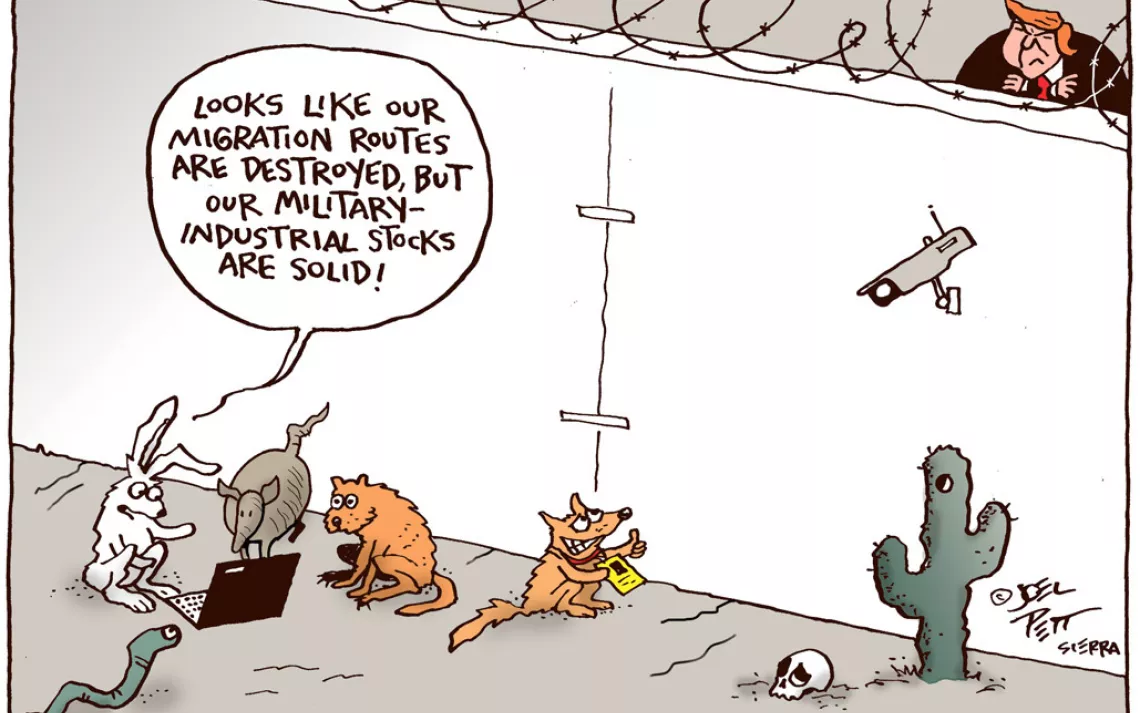The Border Patrol Has Turned the Desert Wilderness Into a Lethal Weapon
Sierra editor Jason Mark on the militarization of our borderlands

Cartoon by Joel Pett
YOU'VE GOT TO BE A LITTLE OUT-THERE to hike up and over a 9,000-foot-high desert peak for fun. You've got to be desperate to do so out of fear—the motivation for migrants from Mexico and Central America who have been forced to climb now that border militarization has placed less dangerous crossings out of reach. For U.S. citizens, the wild of the United States-Mexico border offers a retreat from the cares of daily life. For the poor coming from the south, the desert wilderness serves as an escape route to a hoped-for better life.
The U.S. Border Patrol has figured out an altogether different function for the big, harsh, beautiful landscape of the borderlands: The terrain has been turned into a lethal weapon.
Beginning during the Clinton administration (and escalating its efforts under Presidents Bush and Obama), the Border Patrol has pursued a strategic framework called "prevention through deterrence." The agency built fences and walls in urban areas that had long been dominant migration routes—Tijuana-San Diego, Ciudad Juárez-El Paso, and the twin cities of Nogales—with the intention of pushing migrants into the inhospitable desert. The thinking was that the prospect of crossing the arid, unforgiving landscape would dissuade people from the attempt.
People kept coming anyway, spurred northward by forces beyond their control. Many of those migrants didn't make it. Since 2001, nearly 2,500 bodies have been found in the Tucson Sector alone—that's 10 times the number of people killed at the Berlin Wall during its 28-year existence. The Border Patrol's strategy is calculated homicide disguised as immigration policy.
"The [U.S.] government chose to funnel people through the desert areas, and it created a killing field," Isabel Garcia, of the Tucson-based Coalición de Derechos Humanos (Human Rights Coalition), told me. "They have utilized the desert and the mountains and the climate as a weapon."
I traveled to the Arizona borderlands last spring to investigate how the hardening of the border is harming desert ecosystems and jeopardizing endangered species like the jaguar (see "How Trump's Border Wall Could Block the Most Exciting Wildlife Comeback in North America"). In the Buenos Aires National Wildlife Refuge, remote surveillance stations were scattered across the desert, their towers rising like ship masts above the otherwise unbroken sea of yucca and mesquite. Driving from the border city of Nogales to the Tohono O'odham Nation, I went through four Border Patrol checkpoints. At a trailhead in the Coronado National Memorial, I crossed paths with a half dozen agents preparing to make their rounds.
The evidence is clear: The existing border militarization—to say nothing of Donald Trump's paranoid fantasy of a "great wall"—is expensive and ineffective. People continue to find ways to go over the border with ladders or under it via tunnels. Meanwhile, desert ecosystems and wildlife are getting hammered by bulldozers and barriers.
The hubristic border-security strategy of the United States could use a dose of ecological humility. "Everything flows," John Muir wrote, and the line is as true of people as it is of water and granite. In nature, borders tend toward the fluid and the permeable. So let's consider some biomimicry and keep the wide-open spaces of the desert wildlands wide and open.
This article appeared in the September/October 2017 edition with the headline "Weaponized Wilderness.
 The Magazine of The Sierra Club
The Magazine of The Sierra Club



